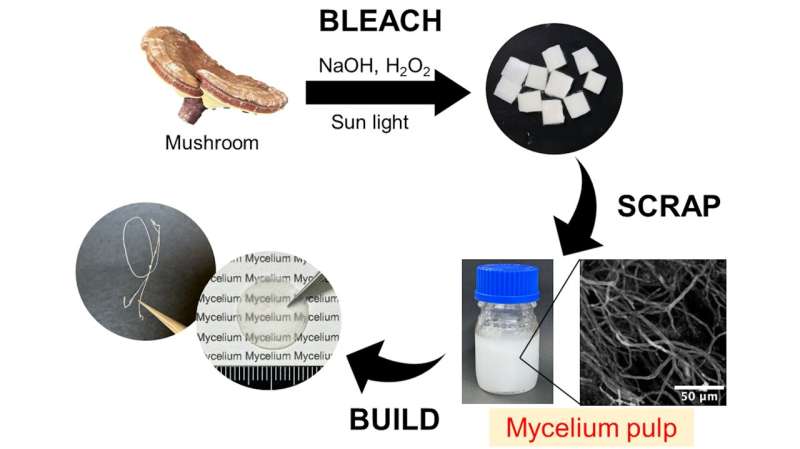This article has been reviewed according to Science X's editorial process and policies. Editors have highlighted the following attributes while ensuring the content's credibility:
fact-checked
peer-reviewed publication
trusted source
proofread
A novel strategy for extracting mycelial fibers for mushroom-based materials

Mycelial fibers, the fibrous cells found in fruiting mushroom bodies, have gained momentum as a sustainable material for making leather and packaging owing to their excellent formability. Recently, a team of researchers from Shinshu University, Japan, has found a simple way of obtaining mycelial fibers, called "mycelial pulp," from fruiting mushroom bodies and bleaching them using sunlight while keeping their mycelial structures intact.
Every year, humans generate millions of tons of waste, and almost 38% of that waste ends up in a landfill. A significant portion of it is made up of plastic or petroleum-based materials that can neither decompose nor degrade with time. This has led scientists to develop materials that are effective yet good for the environment.
One such alternative and renewable resource is mushroom-based materials. The root-like fruiting bodies of mushrooms, also known as mycelial fibers, have shown promising results as the new age, eco-friendly material for a wide range of consumer and industrial applications. The mycelium fibers from the fruiting body contain proteins, chitin, and polysaccharides, which make them ideal for making packaging materials, soundproofing, textiles, and much more.
They are not only versatile but also have low environmental impact, are biodegradable, and have a low cost of production. However, conventional chemical or mechanical treatments used to obtain mycelium fibers have notable shortcomings. Many extraction processes tend to give the materials an unwanted color and often destroy their intricate mycelial structures, thereby limiting their nanoscale applications.
Now, a recent ACS Sustainable Chemistry & Engineering paper, provides a simple and effective way of obtaining mycelial pulp and fibers from mushrooms without destroying their structure.
"Mushrooms, previously known primarily as a food resource, will now be utilized in everyday household items, allowing people to choose products that are safe, reliable, and environmentally friendly," says Assistant Professor Satomi Tagawa from the Faculty of Engineering at Shinshu University, who led this study.
Dr. Tagawa and her team members, Dr. Hiroya Nakauchi, recipient of the Research Fellowship for Young Scientists of Japan Society for the Promotion of Science (JSPS), and Dr. Yoshihiko Amano, Professor at the Faculty of Engineering at Shinshu University, present a novel way of extracting the fibers which ensures that the mycelial structures remain intact.
The team treated the fruiting bodies of enoki mushrooms and the inedible reishi mushrooms with sodium hydroxide and hydrogen peroxide. They then bleached (or decolorized) the obtained substances by exposing them to sunlight.
The now-white material was subjected to ultrasonic treatment to defibrillate the pulp at a mycelial level. This process produced a dispersion containing micrometer-sized mycelium fibers with intact mycelial structures, as verified by Fourier-transform infrared spectroscopy.
The fibers obtained via this process showed excellent deformability and could be used for designing products like 3D porous sponges, 2D films, and 1D yarns.
Apart from obtaining a versatile mushroom-based material, this simple approach makes a valuable addition to the scrap-and-build approach for fabricating mushroom materials, which can complement the existing bottom-up approaches.
"This technology has opened possibilities for upcycling unwanted by-products generated by the mushroom industry and making mushroom materials more circular and easier to reuse. We believe that further research on such sustainable materials and methods could create new industries, provide employment opportunities, and revitalize local communities," says Dr. Tagawa.
More information: Hiroya Nakauchi et al, Preparation of Mycelium Pulp from Mushroom Fruiting Bodies, ACS Sustainable Chemistry & Engineering (2023). DOI: 10.1021/acssuschemeng.3c04795
Journal information: ACS Sustainable Chemistry & Engineering
Provided by Shinshu University




















